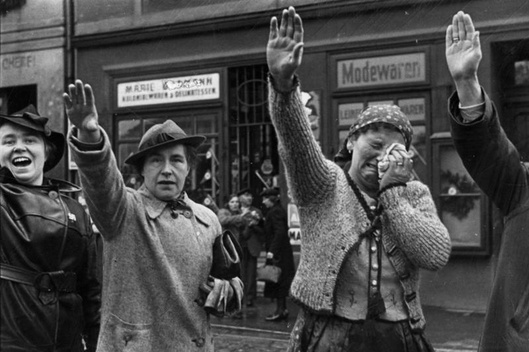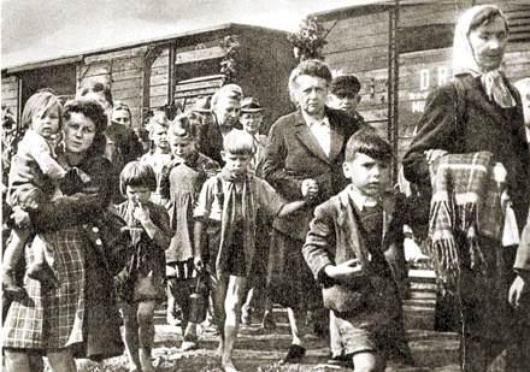![Image for [eng] Lies and Prejudice during the Cold War](https://media.cafebabel.com/resized-images/c9/15/d8a570f74742704844782fd358e8d26fb9ed.jpg)
[eng] Lies and Prejudice during the Cold War
Published on
Translation by:
Laura Massey"History is written by the victors" is a theory that has become universally accepted. However in the history of Czechoslovakia during the interwar period and the Second World War there are no victors. It is a history of murdered Jews, oppressed and exploited Czechs and expelled Sudeten Germans. These diverse groups of people - separated for decades by the Iron Curtain - found completely different ways of recounting the same shared history and thus created a version of events full of reciprocal blame and prejudice which needed joint revision at the end of the Cold War.
Even at the formation of Czechoslovakia after the First World War, tensions between nationalities were inevitable. The mainly German-speaking areas of Bohemia or Moravia claimed their right of self-determination and wanted to ally themselves with the German-Austrian republic or maintain their autonomy within Czechoslovakia. Czech foreign minister, Edvard Beneš, however, claimed that the German settlement areas were not capable of self-government and an ensuing general strike was violently suppressed.
Oppression and Racial Fanaticism
 When the Sudeten German political party, whose ideology was partly rooted in that of the popular struggle, was founded in 1935, it was voted for by 68% of the Sudeten Germans. The party announced its support for Adolf Hitler in 1937 and was ordered by him not to agree to any proposed solutions to the Czech problem in the country's internal conflict. This was one of the reasons why France and Great Britain agreed to an annexation by the German Empire of the German settlement areas. The majority of the Sudeten Germans welcomed the "Anschluss" (annexation) and the Germans were enthusiastically welcomed in many towns, a fact which, in Czech eyes, later legitimised the expulsion of the Sudeten Germans.
When the Sudeten German political party, whose ideology was partly rooted in that of the popular struggle, was founded in 1935, it was voted for by 68% of the Sudeten Germans. The party announced its support for Adolf Hitler in 1937 and was ordered by him not to agree to any proposed solutions to the Czech problem in the country's internal conflict. This was one of the reasons why France and Great Britain agreed to an annexation by the German Empire of the German settlement areas. The majority of the Sudeten Germans welcomed the "Anschluss" (annexation) and the Germans were enthusiastically welcomed in many towns, a fact which, in Czech eyes, later legitimised the expulsion of the Sudeten Germans.
During the dismantling of the German settlement areas, the "rump of Czechia", so named by Hitler, lost half of its territories and most of its centres of industry. The consequences of this were huge economic difficulties as well as complete submission to the German Reich, which on 15th March 1939 moved in and occupied the "rump of Czechia". In the area henceforth known as "the Protectorate of Bohemia and Moravia" Germans were made citizens, but Czechs were not. The German occupiers planned to wipe out all enemies of the Reich and resettle all 'pure' Slavs, or, again, "physically destroy" them. The Nazis deemed only a third of the Czech population to be of racial value and as such they were in line to be Germanized. As a result of the many executions of partisans and members of persecuted minorities, as well as deaths in German prisons and concentration camps, the number of Czech victims of the Nazi regime reached 122,000. In addition, many thousands were forcibly displaced and the Czech population was economically compromised through high war taxes and dispossession.
Expulsion and murder as "fair justice"
 In order to try and solve the nation problem after the war, the Allies planned as early as 1942 to settle the Germans away from Czechoslovakia, so this was not purely a Czech idea.
In order to try and solve the nation problem after the war, the Allies planned as early as 1942 to settle the Germans away from Czechoslovakia, so this was not purely a Czech idea.
Despite the fact that Czech partisans were constantly persecuted, at the end of the war there was an uprising in Prague which only ended with the arrival of the Allied troops. The groups of partisans that did not disband ousted more that half a million Sudeten Germans in the ensuing weeks-long 'breakdown of authority", and carried out frequent acts of cruelty, executions and gruesome death marches. The complicity of the state in this 'barbarous' expulsion (Czech: 'Odsun') was disputed for a long time afterwards, though now the Czechs have conceded that the Army did participate. Once the army had brought the area under control, the state-organised expulsion/resettlement began. Holding and work camps were established to act as transfer bases. From 1945-1948, even children were interred in these camps, sometimes for years, and many died there. Through the Beneš Decrees, all those who had been made citizens of the German Reich in 1945 lost their Czech citizenship. By 1946 Czechoslovakia was an ethnically homongeneous state, three million Germans had been expelled, and Sudeten German villages had been razed to the ground as if they had never existed.
Exact numbers of the loss of life during the expulsion were hard to come by in the aftermath. While in Germany official estimates put the number of those lost at 225,600, Czech researchers often put the total number at far less. It was not until 1997 that a Czech-German commission carried out an investigation which estimated a realistic number of victims to be around 30,000.
It was not only statistics that divided the views of Czechia and Germany or Austria during the Cold War, but also their whole assessment of the expulsion of the Sudeten Germans, which consisted mostly of mutual blame and accusation. Czech historians tended to highlight the Sudeten Germans' support for the Sudeten German party and the Anschluss, as well as the acts of cruelty which occurred during the German Reich's occupation. The German version focused instead on the disregard for the law of the people's right of self-determination in 1918 and on the breaches of human rights during the expulsion. There were just two opinions: either the expulsion of the Sudeten Germans was justified or it was seen as illegal retaliation, any other view was almost completely disregarded.
Reconciliation after the fall of the Berlin Wall?
It has only been in the last 25 years, since the fall of the Iron Curtain, that Czech, German and Austrian historians have started to rethink their viewpoints. A collaboration has resulted in an international and objective consensus. Today the expulsion of the Sudeten Germans is condemned by all sides, but explained within the context of the Second World War. In 2013 a joint national exhibition between Upper Austria and South Bohemia presented the history of Czechoslovakia up to 1945. Even at a regional level, the opening of the border has presented an opportunity for history to be jointly reworked. Many of the expellees have been returning to the towns and villages where they lived, now with little more than the occasional wall to serve as a reminder. Those who return bring house numbers and nameplates with them as memorials for their destroyed villages, and in many places the Czech population work alongside them. For example in Glöckelberg, Southern Bohemia, where there used to be a German village, there is a now a museum remembering the expelled Sudeten Germans. Austria and Czechia have a long shared history; this needs to be jointly remembered to make sure that it can be reviewed and presented in the proper way.
Translated from Lügen und Vorurteile im Kalten Krieg



